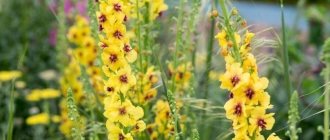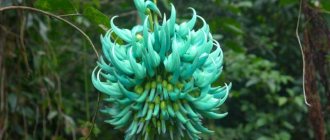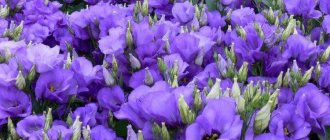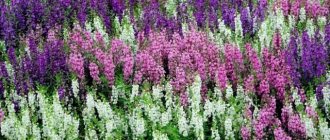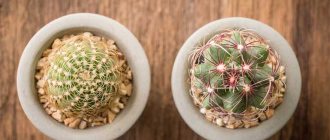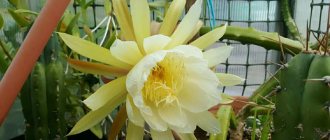Author of the article
Daria Vorontsova
Reading time: 10 minutes
AA
Exotic plants have long been grown at home. After all, they not only create comfort in the apartment, but also have useful properties. Cardamom is called the king of spices; this spice is one of the most expensive in the world. The plant belongs to the ginger family. Its leaves and fruits have a pronounced camphor aroma with notes of mint and citrus.
An evergreen bush can be grown at home on a windowsill, but you will have to put in a lot of effort. But the fragrant bush will please the eye, and you can count on a harvest.
The spicy-sweet spice is added to hot and sweet dishes, or to tea or coffee.
Cardamom varieties for growing on a windowsill
It is possible to grow a bush at home, but the appearance will be slightly different from its counterpart that grew in natural conditions. The most popular varieties of cardamom:
| Variety | Peculiarity |
| Green | The fruits ripen in green boxes, inside of which the grains are brown. One of the most common varieties. In cooking it is added to dough. |
| Black | The plant produces fruits in the form of black grains. Their aroma is similar to the smell of smoke, and they taste sharp. The plant is highly valued both as a spice and for its medicinal properties. |
| Ethiopian | This variety is an analogue of black cardamom. The fruits have a pronounced spicy aroma, but the spice is of lower quality. |
| White | Suitable for food use. The spice has a mild taste and lacks characteristic pungency. |
The most commonly used are black and green cardamom. The black variety has more than 179 subspecies, and the green variety has 11 varieties. Despite the fact that evergreen bushes do not grow in Russia, you can buy seed material at a flower shop.
Cardamom or “Queen of Spices”: cultivation and propagation
The content of the article:
- Recommendations for growing, care
- Self-propagation technology
- Difficulties with home maintenance and solutions
- Interesting Facts
- Kinds
Cardamom (Elettaria) is sometimes called cardamom and most often refers to the fruits of a herbaceous plant with a long life span - true Cardamom (Elettaria cardamomum), which is part of the Ginger family (Zingiberaceae). It also includes up to 52 genera and more than 1,580 species of representatives of the green world of the planet. All of them have one cotyledon in the bud - they are monocotyledons and mainly grow in South or Southeast Asia, where a tropical or subtropical climate prevails, and they can also be found on the lands of the African and American continents. India, namely its Malabar coast, as well as the islands of Ceylon and Sri Lanka, has long been considered the native distribution area of cardamom. If we talk about the 21st century, Guatemala is considered the leader in the production of this spice.
Cardamom has a herbaceous growth form, and the shoots can reach a height of 3–5 meters. The root of cardamom is fleshy, often tuber-shaped, with knotty outlines. It is the basis for the germination of stems with leaf blades. The leaves are large in size, elongated with pointed ends. They are arranged in two rows, their contours are wide, with a lanceolate shape. They originate from the sheath (this is the part at the base of the leaf, widened and groove-like, encircling the stem), formed at the base of the stem. The surface of the leaves is smooth, the color is bright green, they reach 60 cm in length. On both sides of the leaf plate, the central vein is clearly visible, from which smaller veins originate, diverging like a fan in different directions, forming a bizarre pattern.
There are non-leafy shoots, the apex of which is crowned by an inflorescence of a racemose, spicate or paniculate shape. The surface of the petals in flowers is shaded by a white, pale lilac or pale green background, on which there is a pinkish, dark lilac or blue pattern of veins. Often the petals have a light green border. The buds are crowned with elongated pedicels, which usually spread along the surface of the soil. Flowers of both sexes are zygomorphic (they have a single axis of symmetry, usually running along the growth of the shoot). The shape of their hood is usually irregular or resembles a concave tongue.
Upon completion of flowering, greenish fruits, shaped like an oblong box, begin to appear in place of faded flowers. They are somewhat similar to bean pods. Inside it there are multiple seeds, with a greenish or straw color. They are similar to flax seeds and have a rounded or triangular shape. Their surface is wrinkled, their length is up to 4 mm and their width is about 3 mm. They have a sweetish-spicy pleasant aroma. It is this material that is used to make expensive spices.
What you need to grow cardamom
Growing exotic plants at home is painstaking work. After all, in natural conditions they are accustomed to a warm climate and high humidity. In any case, before planting cardamom at home, you need to buy the necessary ingredients.
- Seeds, roots, or cuttings of perennials;
- Spacious container;
- Nutrient substrate;
- Drainage filler;
- Fertilizers for indoor flowers.
Once all the equipment is prepared, you can begin planting. A little patience and love in the process will not be superfluous.
Choosing the optimal place in the house
Room temperature is favorable throughout the life cycle of cardamom. The plant loves warmth and diffused sunlight, so the optimal place in the house is a windowsill. A glazed balcony or loggia is also good. Glass protects the leaves from direct sunlight. In summer, the plant is taken out into the fresh air for several hours a day.
In winter, cardamom is dormant and its growth slows down. However, you should not place pots with bushes in partial shade. The plant will be comfortable on a windowsill on the south side without drafts. When choosing the optimal location in the house, you should choose well-lit areas near windows. The fragrant bushes grow up to a meter in height with long leaves, so it is important to provide the plant with space.
You should not place containers with cardamom near heating appliances. The hot air causes the leaves to dry out and the soil to dry out.
Selection and preparation of containers
You can grow cardamom at home in a spacious container. The roots of this small tree are massive and strong, so the container should be low but wide. These can be either clay pots or ceramic flowerpots.
- Since the plant loves watering, wooden containers should not be chosen due to low moisture resistance.
Before planting, pots or flowerpots are thoroughly washed with running water. Remains of old soil or debris are washed away. If the container is new, then it should not have a specific smell. Then wide holes are made at the bottom to allow water to drain. Pallets are placed under the pots.
Soil selection
A high-quality fertile substrate is 50% of success when growing a cardamom plant at home. The miniature tree prefers loose soil with good moisture and air permeability. Ready-made soil can be bought at a flower shop. A universal substrate or a special one for ornamental plants is suitable.
Do not compact the soil in the pot too much: it should be loose and well-permeable to oxygen.
It is possible to prepare the soil on your own from a mixture of turf soil, humus and sand (2:2:1). Soil rich in humus is also suitable for cardamom. Ideal pH: 5-6. The bottom layer is covered with drainage filler.
Creating the necessary conditions: lighting, air humidity, temperature
Cardamom is demanding on lighting. He loves bright but diffused light. In nature, the evergreen perennial grows under the canopy of trees that diffuse direct sunlight. Despite the fact that the plant is in a state of hibernation in winter, the light intensity cannot be reduced. As additional light, phytolamps are installed at a safe distance from the bush.
The tropical tree responds positively to water treatments in the shower, spraying with warm water and wiping the foliage with a damp sponge. The room where the spice grows is ventilated at least once a day. Like any exotic plant, cardamom loves warmth. Favorable temperature in the room in summer is +20-25°C. In winter, lowering the temperature to +13-15°C does not harm the growth of the tree.
Should you grow exotic plants at home?
Of course not
Soil for cardamom and sowing seeds
For growing at home, prepare a soil mixture for eletarium from 2 parts turf soil, 2 parts humus and 1 part sand. You can take purchased ready-made soil for deciduous ornamental plants.
About cardamom in detail:
Useful properties of cardamom. Contraindications.
The benefits and harms of cardamom in detail. Milk with cardamom. Weight loss
Recipes for tea, coffee with cardamom. Useful properties and contraindications
Soil is poured into a wide shallow container, spilled with water and cardamom seeds are sown, lightly sprinkling the soil with a layer of two cardamom seeds. There are recommendations that after removing the cardamom seeds from the box, rinse them well in warm water to remove the mucous membrane, then mix them with wood ash and leave to dry in the shade for a day; After these procedures, sow.
Cover the crops with glass or place them in a plastic bag and place them in a very warm (25–28 degrees) bright place. Ventilate the container daily to prevent mold from growing, and monitor the temperature and humidity. Eletaria shoots will appear in 30 - 50 days. After germination, the glass or bag is opened slightly, then completely removed; The seedlings are sprayed daily with warm water and protected from drafts.
When the plants grow and become stronger and reach a height of 20–25 cm, they are planted in separate containers. Choose shallow, wide pots; provide good drainage by placing pebbles, broken bricks, expanded clay or clay shards, and a layer of sand on the bottom of the pot.
Growing from seeds
The main feature of growing cardamom on a windowsill from seeds is the freshness of the seed. Fragrant grains quickly lose their viability, so freshly harvested seeds are planted in containers with peat and sand at a temperature of +25°C. There is no need to soak or germinate the seeds before planting.
Preparing seeds for planting:
- Fresh grains are placed in a weak solution of potassium permanganate. The procedure is optional and is used for disinfection purposes;
- Drainage is laid out at the bottom of the pot, soil is poured on top;
- Plant 2 seeds in one container to a depth of at least two centimeters;
- Sprinkle with a thin layer of earth, cover with film or a glass jar;
- In greenhouse conditions, the grains are moistened and periodically ventilated.
The first shoots appear after 1-2 months.
After the first shoots, the sprouts do not need additional shelter. It is enough to provide humidity and warmth.
How to grow cardamom from seeds at home
The key to growing cardamom, especially in a pot at home, is the right substrate, which should be well-drained so that water drains easily but the soil should remain moist at all times. Sandy, loamy soil rich in organic matter and manure is optimal. A slightly acidic or neutral pH level of around 6 - 6.8 is required. It can also tolerate acidic soils up to 5.5 - 6.
The technology for sowing cardamom seeds is as follows:
- Place the seeds in the soil to a depth of two seed diameters.
- Sprinkle with sand.
- Water a little.
- Place glass on top or cover the pot with soil with film.
The container with plantings should be kept indoors at 25 - 28⁰С.
Growing by dividing rhizomes
Propagating cardamom by dividing the roots is the fastest and easiest way. However, for this you will have to wait until the plant gets stronger. This usually takes 6-12 months from the first shoots. The rhizome is carefully cut with a knife so that each part has at least a pair of buds and growing roots. The separated roots with shoots are planted in moist nutrient soil, after which care is provided.
Difficulties in keeping cardamom at home and solutions
If, when growing indoors, the conditions for keeping the eletarium are violated (for example, the humidity level drops), this will lead to the plant being attacked by harmful insects, such as scale insects or spider mites. In this case, the leaf plates begin to turn yellow, deform and dry out, and subsequently fall off. A thin cobweb begins to form on the leaves and in the internodes, and the reverse side of the leaf becomes covered with brown plaques. If measures are not taken to destroy pests, the leaves and shoots become covered with a sticky sugary coating (the waste products of pests) and this can contribute to the development of sooty fungus. In this case, all parts of the plant will become covered with a grayish-black coating. To prevent such a problem, when harmful insects are first identified, it is necessary to treat with insecticidal preparations, for example, Fitoverm, Acrofit or Vermitek. After a two-week period, the treatment is repeated; if pest eggs remain, they too will die.
When a scale insect appears, remove the pest using a cotton swab, and then wipe the cardamom leaf plates with a soap, oil or alcohol solution. Afterwards, the plant is sprayed with an insecticide, and then the plant is covered with plastic wrap and kept in this state for up to half an hour. After two days, the drug must be washed off under a running shower, while the soil in the pot is covered with a plastic bag. This operation is repeated every week. Until the pest is completely destroyed.
Growing by cuttings
Cuttings can only be taken from an adult plant. Ideal length of shoots: 7-10 cm. To do this, cut off the apical shoots of cardamom and place them in a jar of water or wet sand. In order for the cuttings to take root faster, the cutting sites are treated with a growth accelerator solution.
After the roots appear, the standard procedure for planting the plant in a pot follows.
Cuts on the rhizomes are treated with crushed activated carbon so that they do not rot.
Propagation of indoor cardamom
Elettaria can be obtained both from seeds and by vegetative methods.
The easiest way is to propagate cardamom by dividing adult plants. During annual transplantation, you can divide the turf into parts with at least two roots and buds. The sections must be processed, but this is where the difficulties end. Plants are simply planted as independent crops using conventional transplantation technology.
You can also get new specimens of cardamom from cuttings. The tips of the shoots easily take root in a greenhouse at a temperature of 20 to 25 degrees, especially if the cuts are treated with a growth stimulator or rooting agent. The substrate is used standard.
Getting cardamom from seeds is a little more difficult. Seeds are sown exactly at a depth equal to their double width, watered only after sowing, and even then creating a slightly moist environment. The seeds are germinated in the heat, at a temperature of 25 to 28 degrees, with very bright lighting, under glass or film. The seedlings are fragile, but quickly become hardy and actively develop. Cardamom is picked into individual small pots after the second leaf appears. For young plants, transplants are carried out as needed.
Plant care: watering, fertilizing and pruning
Since cardamom comes from warm countries, it loves abundant watering. However, excess moisture at the roots is more critical for the plant than drying out the earthen clod. Water the tropical tree abundantly, avoiding stagnation of water. In summer, watering is needed every day. In winter, it will be enough to moisten the soil once every one and a half to two weeks.
As for feeding, during the period of active growth of seedlings, the soil is fertilized for the first time after 2 months. This is due to the fact that the sprouts absorb maximum nutrients from the soil. Then fertilizing is applied only to stimulate growth in spring and summer. Fertilizers with a mineral-organic composition are ideal.
Cardamom usually blooms in the third year. The flowers are elongated, from soft pink to purple. The tree will not be able to form a lush crown without pruning. The procedure is carried out during the active growth stage in the spring.
How to prune a plant correctly:
- Dense branches that interfere with normal growth of each other are removed;
- The side trunks are cut off so that the main false one actively grows upward;
- A new bush will form if at least a couple of buds remain on the cut shoot.
Cardamom leaves are natural air fresheners.
To ensure that the shoots grow evenly and the crown is lush, the green tops are pinched.
Cardamom Care
Cardamom seeds tend to germinate slowly, so you probably won't see any sprouts for another month. However, their appearance can occur at any time from 2 weeks to 3 months after planting the seeds. Once the shoots emerge, move them to a windowsill where they will only receive sun part of the day, or simply provide them with bright, indirect light.
It is necessary to fertilize for the first time only 2 months after germination. Apply organic plant fertilizers high in phosphorus at least twice a month throughout the growing season.
Closer to late autumn, reduce the temperature and reduce watering. Plant growth will slow down and the leaves will begin to turn yellow. This is normal; cardamom will come out of hibernation in the spring. Then provide it with a higher temperature, regular watering, and high humidity.
The soil should always be slightly moistened, but not too moist. Extremely large amounts of water quickly damage the fleshy rhizome. Humidity is very important for this tropical plant, so mist it often and wash the leaves with a damp cloth from time to time. Use only soft water (such as rain) for watering.
If the plant is in a sunny location, the ideal winter temperature will be between 16 and 20 degrees Celsius. Avoid direct exposure to hot midday sun, especially in summer.
Cardamom grown at home in a pot looks very lush and impressive, even if it does not bloom.
When the plant becomes large (in a few years), you can plant it. When repotting, use a new, large pot to give the rhizome enough room to grow. Divide overgrown plants.
Cardamom (Elettaria cardamomum) is one of the oldest and most expensive spices in the world. It comes from the forests of the mountain range in southern India, where wild cardamom species still grow. Today it is also grown in Sri Lanka, Guatemala, Indochina and Tanzania.
Diseases and pests
Cardamom is susceptible to viral infections among representatives of the flora. In addition, excess humidity can provoke fungal diseases.
Shchitovka
Spider mite
The main pests are scale insects and spider mites. You can destroy the scale insect by treating the leaves with a soap solution. Then the concentrate is washed off so that the solution does not get into the roots. Fight spider mites with insecticides. The preparations “Fitoverm” and “Aktofit” are used in several stages, since they do not act on parasite eggs.
Aktofit
Fitoverm
The main reason for the appearance of pests at home is lack of moisture and dry air. Insects are not repelled by the essential oils contained in the leaves. Small parasites settle on shoots and the inside of leaves and suck the juice out of the plant.
Is it difficult to care for cardamom in the room?
Not really
Black cardamom
All of the above applies to the green cardamom plant, but there is also black cardamom. This is a spice obtained from the seeds of a tree from the ginger family of the genus Atotite, which is a relative of Eletaria, but this plant is not grown at home. Its capsules are larger than the “grains of paradise” green cardamom and can reach 5 cm in length.
This spice has a slightly different aroma, with hints of camphor and smoke. Indians consider it coarser and more earthy, in contrast to the real grain of paradise, and use it in spicy dishes in everyday cuisine.
Author Elena Voroshnina
Photo: flickr.com
Fans of home floristry sooner or later are interested in growing not only ornamental, but also useful plants - the cardamom plant is one of them. It looks beautiful and has practical value. But how to grow cardamom at home?
Description of cardamom
Elettaria cardamomum is an evergreen perennial plant with a fleshy, thick root and two types of stems. One of the shoots is false, directed upward, bears alternate lanceolate dark green leaves, 60 cm long and 8 cm wide. The true second stem is creeping and leafless. The present one has flowers arranged in a brush. The flowers are small in size, one petal is white with a purple pattern in the middle and the rest of the flowers are pale green in color. After they bloom, fruits appear - three-locular boxes 2 cm long. The seeds are fragrant, black, ribbed.
Types of cardamom
Green cardamom (Elettaria cardamomum) is also called true Cardamom or Green Cardamomum, Choti Elaichi. This plant is widespread and actively cultivated in lands ranging from India to Malaysia. The fruits are plump green pods. It is this variety that is of particular value and has quality. The aroma of its seeds is very strong, there is a sweet and pleasant taste. Its smell is comparable to mint. The color of the seeds is dark gray, they are sticky, with an angular shape. The seed material is placed in large rounded boxes of a greenish color.
Black cardamom (Amomum Cardamomum) is a plant in the genus Amomum and you can hear it called Brown Cardamom. People have many names for it: Bengal cardamom, Hawaiian cardamom, Siamese cardamom, or white cardamom and red cardamom. You can hear the name - Kravan or Black cardamom (in England), in France the name Cardamome noir is not uncommon, in Germany - Schwarzer Cardamom, in Italy - Cardamome nero, and the Spaniards call it Cardamome negro.
The pods mature with a dark brown color and are larger than those of the previous variety. Their appearance is somewhat reminiscent of tiny hairy coconuts. There are three chambers inside where the seed material is placed. The length of each seed reaches 3 mm. The taste also varies; it is more tart and has a bitter note, so it is rarely used in making desserts.
In addition to these two most popular types, there are also the following varieties:
- Tall cardamom (Cardamomum longun)
or Cardamomum majus, is distributed in the wild on the island of Ceylon, except for the true cardamom variety, which exceeds its height in height.

